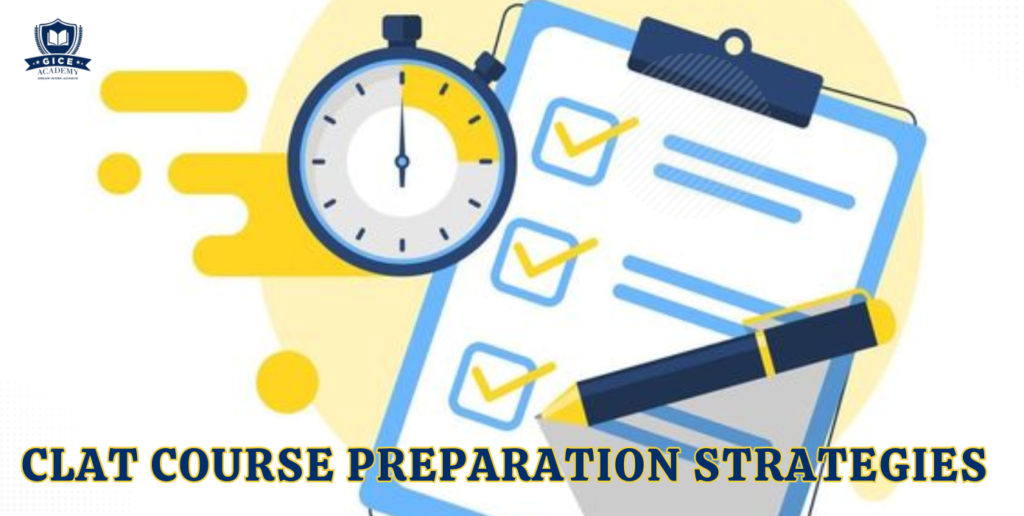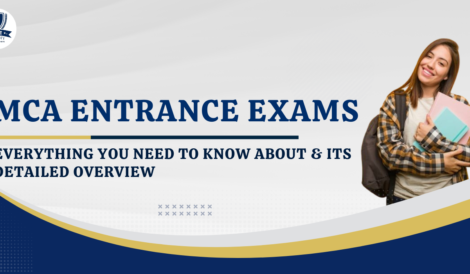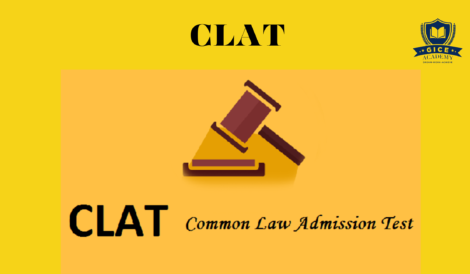Table of Contents
Introduction
The Common Law Admission Test (CLAT) is a national-level entrance exam conducted for admissions to undergraduate (UG) and postgraduate (PG) law programs offered by 22 National Law Universities (NLUs) in India. This exam is crucial for law aspirants aiming to secure a seat in these prestigious institutions. Sponsored by GICE Academy, this blog provides an in-depth understanding of the CLAT Course, covering its structure, exam syllabus, preparation strategies, and more.
CLAT serves as a gateway to premier law colleges, testing candidates’ aptitude in English, general knowledge, legal reasoning, logical reasoning, and mathematics (for UG). Understanding the exam pattern and syllabus is crucial for effective preparation. Stay tuned as we explore each aspect to help you navigate the CLAT journey successfully.
Whether you’re a first-time CLAT aspirant or refining your preparation strategy, GICE Academy offers valuable insights and guidance to excel in this competitive entrance exam.
Overview of the CLAT Exam
The Common Law Admission Test (CLAT) is an essential exam for those seeking admission to top law schools in India. Conducted annually, it assesses the aptitude and skills necessary for a career in law. Both the undergraduate and postgraduate exams are designed to test a candidate’s proficiency in various subjects relevant to the field of law.
CLAT for Undergraduate Programs (UG)
The CLAT UG exam is for students who have completed their 10+2 education and are looking to pursue a bachelor’s degree in law (BA LLB). It serves as a gateway to a robust legal education that forms the foundation for a career in law.
CLAT for Postgraduate Programs (PG)
The CLAT PG exam is for students who have completed their undergraduate degree in law (LLB) and wish to pursue a master’s degree (LLM). This exam focuses on advanced legal concepts and prepares students for specialized legal careers or academic roles.
CLAT Exam Eligibility Criteria
Undergraduate (UG) Eligibility
To be eligible for the CLAT UG exam, candidates must:
- Have completed 10+2 or equivalent with a minimum of 45% marks (40% for SC/ST candidates).
- Be below 20 years of age (22 years for SC/ST and PWD candidates).
Postgraduate (PG) Eligibility
For the CLAT PG exam, candidates must:
- Have completed an LLB degree or equivalent with a minimum of 50% marks (45% for SC/ST candidates).
- There is no upper age limit for the CLAT PG exam.
Structure of the CLAT
The CLAT structure varies for UG and PG programs, focusing on different areas of law and general aptitude.
UG CLAT Exam Pattern
The UG CLAT exam pattern consists of 150 multiple-choice questions (MCQs) to be completed in 2 hours. The questions are divided into the following sections:
English Language: Comprehension passages and grammar.
Current Affairs, including General Knowledge: Recent events and general knowledge.
Legal Reasoning: Legal propositions and scenarios.
Logical Reasoning: Analytical and critical thinking.
Quantitative Techniques: Basic mathematics and data interpretation.
PG CLAT Exam Pattern
The PG CLAT exam pattern consists of 120 multiple-choice questions (MCQs) to be completed in 2 hours. The sections include:
Constitutional Law: Fundamental principles and provisions.
Jurisprudence: Theoretical aspects of law.
Other Law Subjects: Contracts, Torts, Criminal Law, International Law, Environmental Law, and Human Rights.
CLAT Syllabus for UG and PG Programs
UG Program Syllabus:
The CLAT-UG syllabus covers a range of subjects aimed at testing the general aptitude and awareness of candidates.
- English Language
- Comprehension Passages
- Grammar
- Vocabulary
- Synonyms and Antonyms
- Current Affairs, including General Knowledge
- National and International Events
- Awards and Honors
- Sports
- Important Dates
- Legal Reasoning
- Legal Principles
- Law of Torts
- Contracts
- Criminal Law
- Logical Reasoning
- Analytical Reasoning
- Logical Sequences
- Syllogisms
- Critical Reasoning
- Quantitative Techniques
- Arithmetic
- Algebra
- Geometry
- Data Interpretation
PG Program Syllabus:
The CLAT PG syllabus is designed to test an advanced understanding of law.
- Constitutional Law
- Fundamental Rights
- Directive Principles
- Amendments
- Judiciary
- Jurisprudence
- Legal Theories
- Schools of Jurisprudence
- Legal Concepts
- Other Law Subjects
- Contract Law
- Tort Law
- Criminal Law
- International Law
- Environmental Law
- Human Rights
CLAT Course Preparation Strategies

Understand the Exam Pattern
Knowing the CLAT exam pattern is crucial for effective preparation. Both CLAT UG and CLAT PG have their own unique structures that candidates must be familiar with.
Create a Study Plan
A well-structured study plan helps in covering all topics systematically. Allocate time for each section based on its weight in the exam.
Practice Regularly
Regular practice through mock tests and previous-year papers can significantly enhance your preparation. It helps in understanding the type of questions asked and improving time management.
CLAT Course: Focus on Weak Areas
Identify your weak areas and dedicate extra time to improving them. Seek help from mentors or join coaching classes if necessary.
Stay Updated
For the Current Affairs section, staying updated with the latest news and events is crucial. Reading newspapers, following news websites, and using mobile apps for daily updates can be helpful.
Join Study Groups
Joining study groups or forums can provide additional support and motivation. It allows for discussion of difficult topics and sharing of resources.
Recommended Books and Resources
For CLAT UG
- English Language: Word Power Made Easy by Norman Lewis, High School English Grammar and Composition by Wren & Martin
- Current Affairs: Manorama Yearbook, Newspapers like The Hindu and Indian Express
- Legal Reasoning: Legal Awareness and Legal Reasoning, by A.P. Bhardwaj
- Logical Reasoning: Analytical Reasoning by M.K. Pandey
- Quantitative Techniques: Quantitative Aptitude for Competitive Examinations by R.S. Aggarwal
For CLAT PG
- Constitutional Law: Introduction to the Constitution of India by D.D. Basu
- Jurisprudence: Jurisprudence and Legal Theory by V.D. Mahajan
- Other Law Subjects: Various textbooks covering Contracts, Torts, Criminal Law, etc.
How to Apply for CLAT
Step-by-Step Application Process
- CLAT Registration: Visit the official CLAT website and register using your email ID and phone number.
- Fill out the Application form: Provide personal details and educational qualifications, and upload necessary documents.
- Upload Documents: Upload scanned copies of your photograph, signature, and other required documents.
- Pay Application Fee: Pay the application fee through online mode using a credit card, debit card, or net banking.
- Submit Application: Review the application form and submit it. Take a printout of the application confirmation for future reference.
Important Dates
Keep track of important dates related to the application process, exam date, and result announcements by regularly checking the official CLAT website.
Exam Day Guidelines

What to Bring
- Admit Card: Download the CLAT admit card from the official website and carry a printed copy.
- Photo ID: Carry a valid photo ID proof such as Aadhar Card, Voter ID, or Passport.
- Stationery: Bring required stationery, like a black/blue ballpoint pen.
Exam Day Tips
- Arrive Early: Reach the exam center at least an hour before the reporting time.
- Read Instructions: Carefully read all instructions on the question paper and OMR sheet.
- Time Management: Manage your time efficiently, ensuring you attempt all sections.
Post-Exam Process
Answer Key
The provisional answer key is released a few days after the exam. Candidates can challenge the answers if they find discrepancies.
CLAT Result Declaration
CLAT results are declared on the official CLAT website. Candidates can check their results using their login credentials.
CLAT Counseling Process
Qualified candidates are called for the CLAT counseling process based on their ranks. They need to fill their preferences for NLUs, and seats are allotted accordingly.
Seat Allotment
During the seat allotment process, candidates are assigned seats based on their rank, preference, and availability of seats in the preferred NLU.
Conclusion
By following the guidelines and strategies mentioned in this guide, candidates can effectively prepare for theDiscover everything you need to know about the CLAT course in this in-depth guide. Learn about CLAT exam preparation, eligibility criteria, syllabus, preparation tips, exam pattern, and more to excel in your law entrance exam. and increase their chances of securing admission to one of the top National Law Universities (NLUs) in India. Proper understanding of the CLAT course structure, CLAT eligibility criteria, and CLAT preparation methods is key to achieving success in this highly competitive law entrance exam.
Sponsored by GICE Academy, this comprehensive resource aims to equip candidates with the knowledge and tools necessary to excel in the CLAT. In addition to CLAT, understanding the Master of Computer Applications (MCA) program and its entrance requirements will be explored in our upcoming blogs.
1. What is the eligibility criteria for CLAT UG?
To be eligible for the CLAT UG exam, candidates must have completed 10+2 or equivalent with a minimum of 45% marks (40% for SC/ST candidates) and be below 20 years of age (22 years for SC/ST and PWD candidates).
2. What is the eligibility criteria for CLAT PG?
For the CLAT PG exam, candidates must have completed an LLB degree or equivalent with a minimum of 50% marks (45% for SC/ST candidates). There is no upper age limit for the CLAT PG exam.
3. How is the CLAT UG exam structured?
The CLAT UG exam consists of 150 multiple-choice questions (MCQs) to be completed in 2 hours. The sections include English Language, Current Affairs, including General Knowledge, Legal Reasoning, Logical Reasoning, and Quantitative Techniques.
4. How is the CLAT PG exam structured?
The CLAT PG exam consists of 120 multiple-choice questions (MCQs) to be completed in 2 hours. The sections include Constitutional Law, Jurisprudence, and Other Law Subjects.
5. What are the best books for CLAT UG preparation?
For CLAT UG, recommended books include Word Power Made Easy by Norman Lewis, High School English Grammar and Composition by Wren & Martin, Manorama Yearbook, Legal Awareness and Legal Reasoning by A.P. Bhardwaj, Analytical Reasoning by M.K. Pandey, and Quantitative Aptitude for Competitive Examinations by R.S. Aggarwal.
6. What are the best books for CLAT PG preparation?
For CLAT PG, recommended books include Introduction to the Constitution of India by D.D. Basu, Jurisprudence and Legal Theory by V.D. Mahajan, and various textbooks covering Contracts, Torts, Criminal Law, etc.
7. How do I apply for CLAT?
To apply for CLAT, candidates need to register on the official CLAT website, fill out the application form, upload necessary documents, pay the application fee, and submit the application.
8. What should I bring to the exam center on exam day?
On exam day, bring your CLAT admit card, a valid photo ID proof such as Aadhar Card, Voter ID, or Passport, and required stationery like a black/blue ballpoint pen.
9. What is the process after the CLAT exam?
After the CLAT exam, the provisional answer key is released, followed by the result declaration. Qualified candidates are called for the CLAT counseling process based on their ranks, where they fill their preferences for NLUs and seats are allotted accordingly.
10. How can I stay updated with the latest CLAT updates?
Stay updated with the latest updates on CLAT by regularly checking the official CLAT website for announcements related to exam dates, eligibility criteria, application processes, and more.





